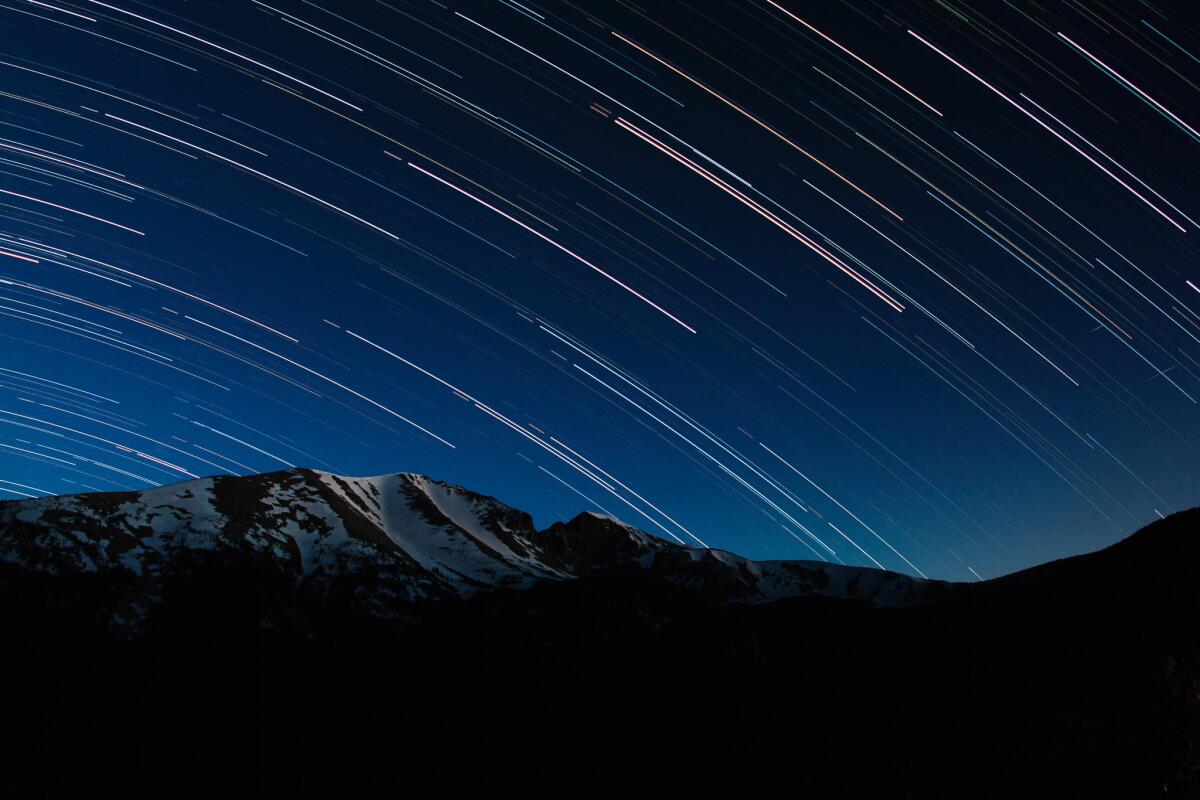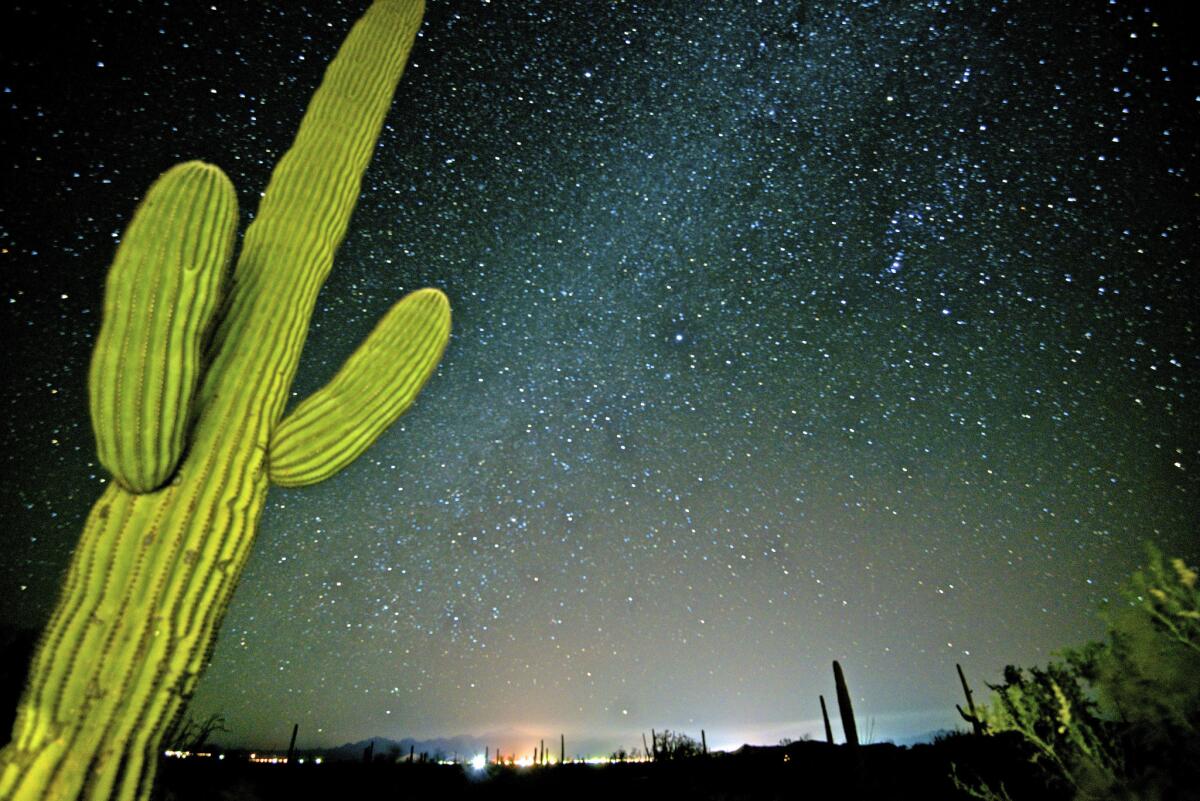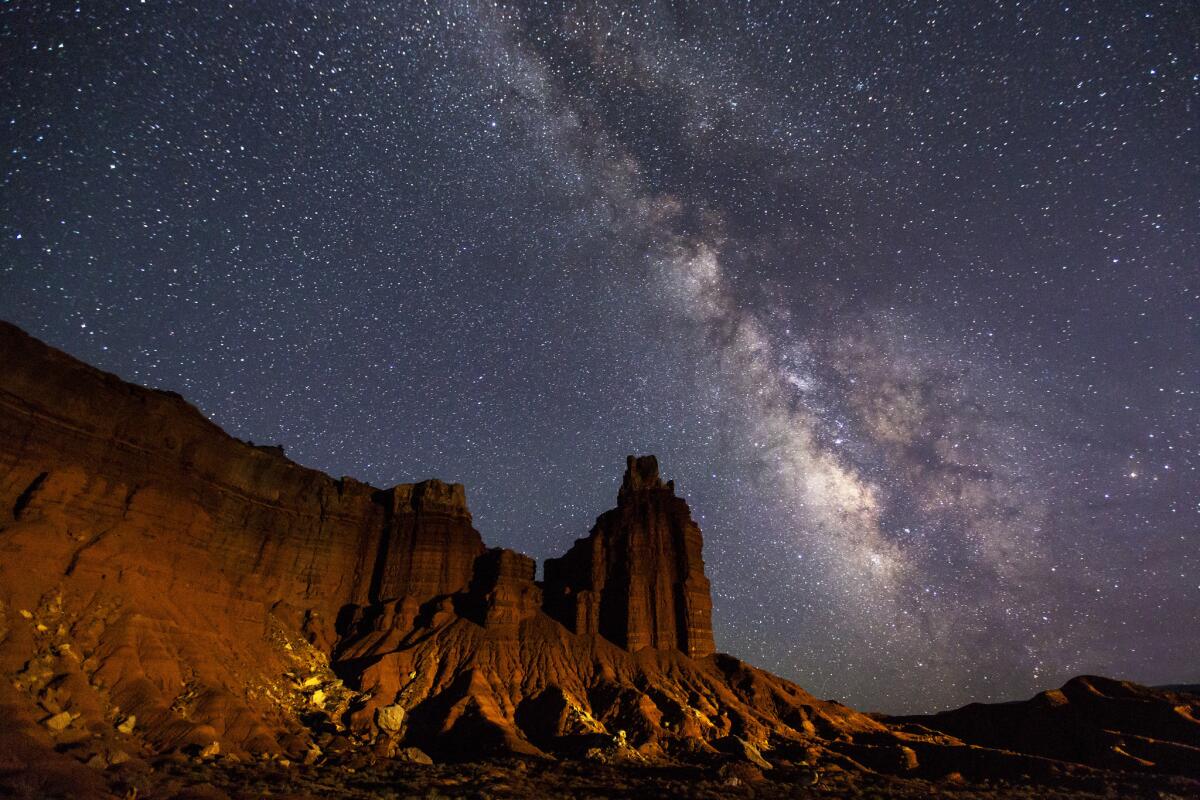Away from the city lights of the West, the night sky promises a dazzling celestial show
- Share via
When I was a kid, summers meant evenings outside, falling asleep while watching stars parade westward over my family’s corn and cotton fields in Northern California. My star atlas sat by my sleeping bag, its spine ragged from constant use, its pages sloughing off by the score.
Only gathering clouds could thwart my regular communion with the heavens.
Now that I live in Southern California, it’s the Orange County Sheriff’s Department’s helicopters I’m most likely to see when I look up at night.
See the most-read in Life & Style this hour »
But my love for the celestial wilderness persists.
That desire has led me to pockets of the West, far removed from light pollution, airport strobe lights and the Vegas Strip’s incandescence, where even novice star seekers can rediscover the Andromeda galaxy and Jupiter’s moons.
Here are places where I’ve bathed in the starshine. Some experiences have been more redolent with heavenly bodies than others, but each site sits under a sky far darker than most.
California
Most of California’s population — and thus the luminescence from city lights — is along its southerly coast, so the nearest escape for dark skies is the deserts to the east. Recognizing that, rangers have worked to make Joshua Tree National Park a haven for urbanites seeking ebony skies.
“It’s a fantastic area for viewing the stars,” said ranger Pam Tripp, one of Joshua Tree’s interpreters who specialize in astronomy. “On a nice, clear night, you can see the Milky Way, lots of constellations and even satellites.”

One excellent spot is the Pinto Basin area in the southern part of the park, farther from the pesky lights of Palm Springs and Twentynine Palms. Many skygazers like Keys View, which has wide-open vistas. That locale overlooks Palm Springs and its accompanying lights, but it still leaves plenty of darkness for stars to shine.
The park’s roads have plenty of turnoffs, Tripp noted, that are often good spots to stop, step safely away from the road and gaze upward.
Keep an eye out for ranger talks on astronomy or special events such as full-moon hikes.
Info: Joshua Tree National Park, 74485 National Park Drive, Twentynine Palms. $20 entrance fee; camping is $15-$20 per night
Nevada
Great Basin National Park has the finest skyward vistas I’ve witnessed in the Northern Hemisphere. From the thin air of 13,063-foot Wheeler Peak to the Snake Valley below it, the park is considered one of the country’s prime stargazing spots.
Several mountain ranges surround Great Basin, at the extreme eastern edge of Nevada. Most important, Salt Lake City is a four-hour drive east and the glittering gulch of Las Vegas a five-hour drive south, leaving the park blessed with a Tartarus-like lack of artificial light.

Not that there isn’t light; Nicole Andler, the park’s chief of interpretation, fondly remembers the words of one 8-year-old camper she met.
“She said, ‘There are more spots of light than there is darkness,’ ” Andler recalled, referring to the thousands of stars visible on clear nights.
Despite the remote location, the park attracts amateur astronomers who assist the “dark rangers” in introducing the public to the celestial sphere. I once attended a sky viewing that, instead of lasting 90 minutes, went nearly 3½ hours. The amateur astronomers and dark rangers gave their own time and endured icy winds to show off galaxies and nebulae to an entranced audience.
Light pollution prevents 1 in 3 Earthlings from seeing the Milky Way at night »
If that’s not convincing enough, the park’s visitor center lights are now red, the only color that doesn’t disturb night vision.
Any spot here with a fairly open horizon is a good place to look up, but Andler suggests the Baker Creek or Lower Lehman Creek campgrounds, or the Baker Archaeological Site just outside the park.
One good thing to keep in mind: Much of the park is at a higher elevation, so even in summer the weather can change quickly. Wear sensible clothing when visiting.
Info: Great Basin National Park, 5500 W. Highway 488, Baker, Nev. No entrance fee; camping is $12 per night.
Arizona
Out of all the stops on this list, Lowell Observatory in Flagstaff is the only place where you can’t roast marshmallows while trying to trace Sagittarius in the sky. This is where Clyde Tombaugh discovered Pluto, which reigned as the solar system’s outermost planet from 1930 until its unfortunate demotion in 2006.
Reader Photo: Six stargazing photographers capture the Milky Way galaxy »
Of course, no visit is complete without one of the Pluto tours. The excursion guides visitors through the small, wooden observatory that first captured a photo of Planet X, the astral midget that later earned the title Pluto.
One exhibit uses sidewalks on the grounds to show the relative distance of the planets from the sun. Pluto is a decent walk.
Pluto tours take place during the day, but come back at night to peer at the heavens through the Clark Telescope, a 24-inch refracting telescope in use since 1896.
Info: Lowell Observatory, 1400 W. Mars Hill Road, Flagstaff. Cost is $12 for adults; $11 for seniors, military and students; $6 for ages 5-17; free for 5 and younger. Admission covers day and evening programs.
On one trip to lonely but lovely Organ Pipe Cactus National Monument, I was lucky enough to witness the Milky Way spilling across the entire sky. It helps that this desert locale is ideal for visiting or camping in the winter, when the night sky orients itself toward the bright stars in our neighborhood of the galaxy.

The national monument has plenty of flat land, making just about any spot a good place to view objects closer to the horizon such as the elusive planet Mercury. Stop by the visitor center and ask a ranger about camping at Alamo Canyon — a small, remote campground with a front seat to the galactic spectacle.
Info: Organ Pipe National Monument, 10 Organ Pipe Drive, Ajo. $12 entrance fee; camping is $10-$16 per night.
Utah
I’ve fallen madly in love with southern Utah and its Salvador Dalí-esque terrain as well as a loneliness that serves as a salve for the frenetic Southern California lifestyle.
But I happily found out it’s just as gorgeous at night, when the silence in the arid atmosphere almost allows one to hear the twinkling of stars.
Though not far from its sister parks, Zion and Bryce Canyon, Capitol Reef National Park gets fewer visitors, meaning there are fewer people to spoil celestial contemplation with car headlights or loud blather.

This is canyon country, but it’s not difficult to find wide vistas, especially for those willing to hike a bit. Try Sunset Point for that. For a more idle experience, stop by the Gifford Homestead in the historic district of Fruita. Grab some pie and sarsaparilla and wait for the stars to emerge, one by one, above the historic orchards.
Info: Capitol Reef National Park, 52 W. Headquarters Drive, Torrey. Entrance fee is $10; camping is $20 a night, with some free camping on Bureau of Land Management areas just outside the park.
Stargazing tips
You don’t have to be Neil deGrasse Tyson to appreciate the stars, and you don’t need special equipment — just a dark spot, a clear sky and a healthy curiosity — but here are some suggestions:
— Wear warm clothes and take a blanket. At night, the cooler air and heightened humidity can chill a stargazer even in summer. Also, putting the blanket on the ground and lying on it can prevent neck cricks after looking up too long.
— Close your eyes and count to 100 to help establish your night vision. It may take up to 45 minutes for your eyes to fully acclimate to the dark, so be patient.
— Besides wearing warm clothes, it’s imperative to use a modified flashlight that shines dark red light, not white. Red is the only wavelength of visible light that doesn’t interfere with a person’s night vision. An easy way is to cover the flashlight lens with a couple sheets of red cellophane. A better method is to paint the lens with one or two coats of red nail polish.

— Use binoculars. Telescopes are great but have a limited field of view. Even an inexpensive pair of binoculars can bring into sight objects the naked eye can’t capture.
— Use a star chart. There are several smartphone apps that can help identify objects in the heavens, but printed sky charts offer a more expansive map of the sky. Free charts are available on several websites such as EarthSky.
— Peek at a calendar that shows moon phases. A moon that’s full or close to it will overwhelm all but the brightest stars around it. Stargaze during the new moon or before the moon has risen or after it has set.
Sources: National Park Service, EarthSky
Upcoming star parties and astronomy festivals
June 29-July 2, Golden State Star Party, near Adin, Calif.: This event promises dark skies in rural northeastern California. Camping is available. Events are to be determined, but past years have included telescope viewing and lectures. Registration required, $70 or $25 per night. goldenstatestarparty.org
Sept. 29-Oct. 1, Great Basin National Park: During the day, solar telescopes will be available to safely view the sun. In the evenings, visitors can peek through more than 30 telescopes trained on celestial objects. Free. www.nps.gov/grba
Oct. 28-30, Joshua Tree National Park: Sponsored by the National Park Service and Sky’s the Limit, a nonprofit educational organization that runs a small observatory near the northern entrance of the park.The schedule is yet to be determined, but may include “sky” walks, lectures, sky observations through telescopes and children’s activities. Events are free with $20 park admission. www.lat.ms/nightskyfestival
ALSO
Gorgeous scenery, abundant wildlife and friendly people: What's not to like about the Black Hills?
These 14 desert parks are the hottest destinations in the Southwest
Discover our desert national parks and rediscover yourself. You can start with Joshua Tree
Sign up for The Wild
We’ll help you find the best places to hike, bike and run, as well as the perfect silent spots for meditation and yoga.
You may occasionally receive promotional content from the Los Angeles Times.



